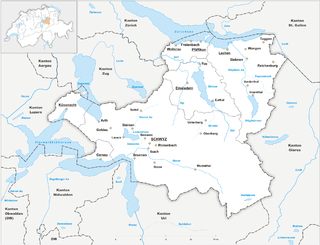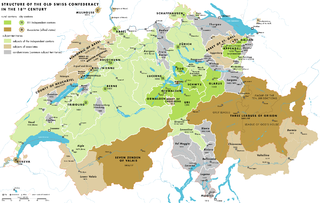The Pact of Brunnen (Bund von Brunnen) is a historical treaty between the cantons of Uri, Schwyz, Unterwalden, concluded in Brunnen on 9 December 1315.

The canton of Uri is one of the 26 cantons of Switzerland and a founding member of the Swiss Confederation. It is located in Central Switzerland. The canton's territory covers the valley of the Reuss between the St. Gotthard Pass and Lake Lucerne.

The canton of Schwyz is a canton in central Switzerland between the Alps in the south, Lake Lucerne to the west and Lake Zürich in the north, centered on and named after the town of Schwyz.

Unterwalden is the old name of a forest-canton of the Old Swiss Confederacy in central Switzerland, south of Lake Lucerne, consisting of two valleys or Talschaften, now two separate Swiss cantons, Obwalden and Nidwalden.
Representatives of the four territories (Unterwalden was composed of Obwalden and Nidwalden) met in Brunnen after the success of the Battle of Morgarten in the previous month to renew the promise of mutual military assistance. In 1318, Leopold I, Duke of Austria concluded a truce with the confederates. [1] According to Aegidius Tschudi, the pact of Brunnen marks the decision to make what had been a pragmatic alliance a permanent, sworn confederacy, initiating the phase of growth of the Old Swiss Confederacy, with the accession to the pact by Lucerne in 1332 and Zürich in 1351, Glarus and Zug in 1352 and Bern in 1353. [2]

The Battle of Morgarten occurred on 15 November 1315, when a 1,500-strong force from the Swiss Confederacy ambushed a group of Habsburg soldiers on the shores of Lake Ägeri near the Morgarten Pass in Switzerland. The Swiss, led by Werner Stauffacher, defeated the Habsburg troops, who were under the command of Duke Leopold I. The Swiss victory consolidated the Everlasting League of the Three Forest Cantons, which formed the core of modern Switzerland.

Leopold I from the House of Habsburg was Duke of Austria and Styria – as co-ruler with his elder brother Frederick the Fair – from 1308 until his death. Born at Vienna, he was the third son of King Albert I of Germany and Elisabeth of Gorizia-Tyrol, a scion of the Meinhardiner dynasty.

AegidiusTschudi was a Swiss statesman and historian, an eminent member of the Tschudi family of Glarus, Switzerland. His best known work is the Chronicon Helveticum, a history of the early Swiss Confederation.
While there are a number of earlier treaties of a similar nature, the treaty of Brunnen is particular because it was the first to be worded in German language rather than Latin. The treaty was long regarded as the foundational document of the Old Swiss Confederacy, until the Federal Charter of 1291 surpassed it in prominence during the first half of the 20th century.
Middle High German is the term for the form of German spoken in the High Middle Ages. It is conventionally dated between 1050 and 1350, developing from Old High German and into Early New High German. High German is defined as those varieties of German which were affected by the Second Sound Shift; the Middle Low German and Middle Dutch languages spoken to the North and North West, which did not participate in this sound change, are not part of MHG.

The Old Swiss Confederacy was a loose confederation of independent small states within the Holy Roman Empire. It is the precursor of the modern state of Switzerland.

The Federal Charter or Letter of Alliance documents the Eternal Alliance or League of the Three Forest Cantons, the union of three cantons in what is now central Switzerland. It is dated in early August 1291 and initiates the current 1 August Swiss National Day. This agreement, in Latin, cites a previous similar pact. It is currently exhibited at the Museum of the Swiss Charters of Confederation in Schwyz.










